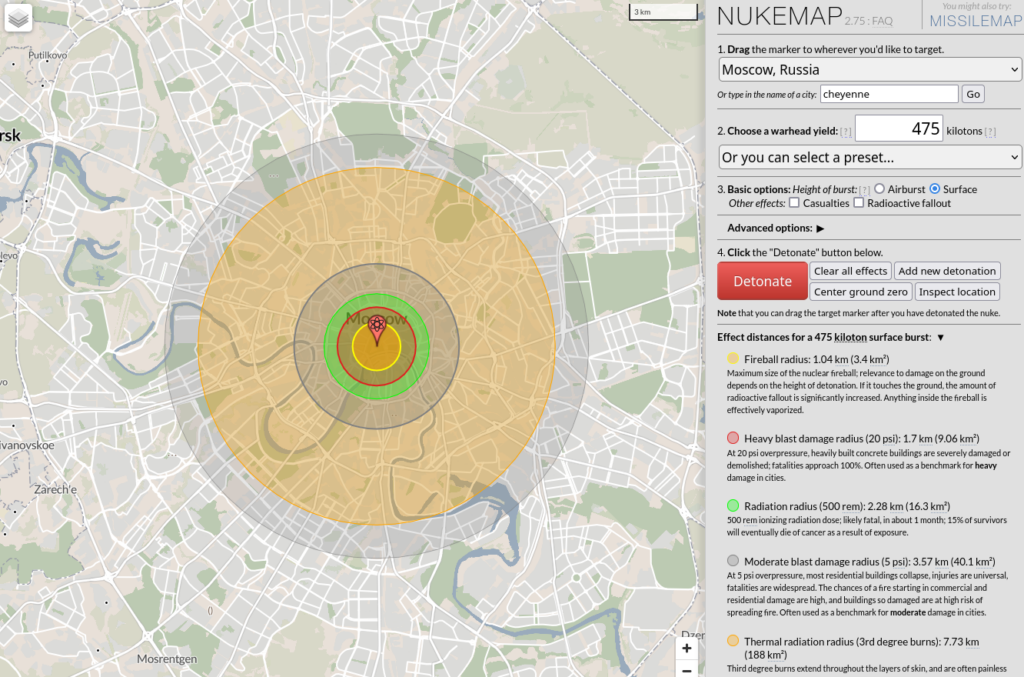Update: as a nuclear war with Russia is growing more plausible especially if they allow Ukraine to fire NATO weapons further into Russia, familiarizing yourself with blast yields and types of weapons is very illuminating. And you can visualize using the Nukemap pictured below with detailed zones of impact.
To bottom line it, one Borei-class submarine can launch 160 100-150kt nuclear warheads with guidance systems and a 9,300 km/5,770 mile range (story below). Hiroshima and Nagasaki were in the 20kt range. Just one submarine with the new missiles is capable of inflicting a lot of damage, and the closer in they are the less warning there would be. And if you think the crews wouldn’t fire the missiles, they run constant fire exercises and the crews don’t know if it’s a drill or a real launch until after they’ve put in the codes and turn the switches. So they would get launched if called on to do so. Compare to our land based nuclear missiles where we have 400 missiles with up to 475kt warheads and 8700 mile range, but unclear on how many total warheads and yields which can be 300kt as well. And you can add in our submarines with Trident missiles with similar yields. But you might be surprised to see the blast zones for these weapons, with the largest yields reserved for bombs. And you can use the tool below to look at your city and play with yields.


The Russian army has adopted the Bulava sea-based intercontinental ballistic missile. The adoption was confirmed by the general designer of the Moscow Institute of Thermal Engineering. The decree was officially signed on May 7, 2024.
Bulava is a submarine-launched ballistic missile (SLBM) is designed to arm submarines of Project 955 (Borey) and Project 955A (Borey-A). It is one of the cornerstones of Russia’s nuclear triad, and is one of the most expensive weapons project in the country.
Designed by Moscow Institute of Thermal Technology, development of the missile was launched in the late 1990s as a replacement for the R-39 Rif solid-fuel SLBM. The Project 955/955A Borei-class submarines carry 16 missiles per vessel. The range of the missile exceeds nine thousand kilometers. The missile has up to ten hypersonic maneuvering nuclear warheads of individual guidance with a capacity of 100-150 kilotons each.

In recent years, there have been several reports of the adoption of the Bulava missiles by the Russian army, but they have not been officially confirmed.
The missile has been developed since 1998, and the Bulava launches have been carried out since 2004. From 2006 to 2009, there were a number of unsuccessful launches, some of them ended with explosions. Another failure took place in 2013. The state commission then concluded that the reason for the unsuccessful launch could be a manufacturing defect. By the end of 2022, 40 test launches were carried out, after 2013 the tests were carried out successfully.
In November 2023, the Bulava was launched from the submarine “Emperor Alexander III” as part of the tests of this vessel. The launch was considered successful, the missile hit targets at the Kura test site in Kamchatka.
Russian President Vladimir Putin noted in December 2022 that these weapons “significantly enhance the capabilities of the nuclear naval forces” of the Russian navy.
Moscow maintains the initiative in the construction of its nuclear submarine fleet. Amid the hostile policy of Washington and denouncement of international treaties, the timely adoption of the Bulava SLBM is a clear sign to Russia’s enemies.